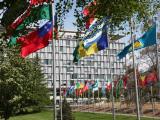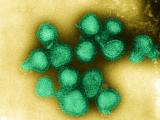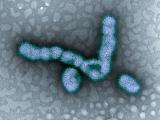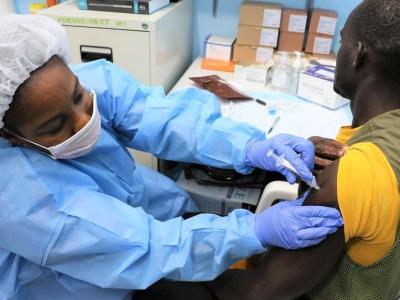Jun 9, 2009 (CIDRAP News) – The World Health Organization (WHO) is getting "very close" to declaring that a novel H1N1 influenza pandemic has arrived, but the agency wants to spend more time preparing the world for that step so it won't cause panic, a WHO official said today.
In view of the virus's spread in Australia, far from the epidemic epicenter in North America, "We are getting really very close to knowing that we're in a pandemic situation or declaring that we're in a pandemic situation," Dr. Keiji Fukuda, the WHO's assistant director-general for health security and environment, said at a press briefing today.
But before declaring a pandemic, the WHO wants to do more to reduce the risk of panic and overreactions such as trade embargoes, border closures, travel restrictions, and a flood of "worried well" people in hospital emergency departments, Fukuda said.
"One of the things we're really focusing on right now is to help countries, help institutions, help the media really understand what are pandemics and provide as much information as possible so we reduce any adverse effects . . . and prevent misunderstanding that may lead to actions that really increase anxiety in people," he said.
Meanwhile, WHO Director-General Dr. Margaret Chan told the Associated Press (AP) today that "on the surface of it," a pandemic appears to be under way. She said she would confer with governments tomorrow to verify some of the reports she has received before making a formal announcement, the AP story said.
"Once I get indisputable evidence, I will make the announcement," the AP quoted Chan as saying.
Scary terminology
The WHO has had its pandemic alert level at phase 5 since Apr 29. Phase 5 means a novel virus has achieved sustained community transmission in more than one country within one global region, and it suggests that a pandemic is imminent.
Phase 6, the peak stage, means a novel virus is spreading in more than one global region and the pandemic has arrived. The WHO's phase definitions characterize only the disease's geographic spread, not its severity.
Because the virus is well-established in North America and now seems entrenched in Australia as well, the current situation seems to fit the WHO's criterion for phase 6. But the WHO has held off on announcing phase 6 out of concern that it would cause unnecessary alarm, given that the novel virus causes mild disease in most cases.
The problem, WHO officials have said, is that after years of preparing for the threat of a pandemic strain of the deadly H5N1 avian influenza virus, many governments and people think of a pandemic as a deadly worldwide plague.
Last week Fukuda said the WHO would come up with a way to describe the severity of the H1N1 threat and couple that with any pandemic declaration, in an effort to prevent undue alarm. Today he indicated that the agency is still working on a severity scale and other information to provide when announcing the move to phase 6.
"One of the things many countries have been struggling with is that their existing pandemic plans have been based on a more severe scenario, the H5N1 virus, so some of the things their plans called for may be inappropriate," he said.
As for the kinds of adverse effects the WHO fears if it declares a pandemic too soon, Fukuda cited several things that have already happened in some places since the novel virus emerged: misguided culling of pigs because of the term "swine flu," trade embargoes, concern about travelers from affected countries, concern about border closures, and travel restrictions.
"In the past, people who were worried but not particularly sick have overrun hospitals," he added.
Managing the media?
Fukuda was asked if, in delaying the pandemic declaration, the WHO is just trying to "manage the media."
He replied that moving to phase 6 "is not simply getting up in front of press cameras and making an announcement, it's really a way to prepare the world to deal with the situation." He said countries need information and tools for dealing with the epidemic and added that much work is being done on communication, vaccine development, antiviral drug supplies, and clinical guidelines.
"This is not managing the media, this is not nuancing the messages, this is really getting countries and populations ready so they can handle and deal with this virus as well as possible," he asserted.
"One of the critical issues is we do not want people to over-panic if they hear that we're in a pandemic situation and that they understand for example that this is a moderate level [of disease]," he said in answering further questions.
Some victims previously healthy
In other comments, Fukuda said the WHO is concerned that about half of the patients who have died of the new virus did not have pre-existing health problems—an observation he has mentioned at earlier briefings.
"It's probably fair to say approximately half of the people who have died have been previously healthy people. This is I think one of the observations that gives us the most concern," he said. "From the outset and from reports coming from Mexico, we knew that a number of deaths had taken place among younger people who were previously healthy. This is a pattern we've seen with the H5N1 virus and one we've seen in previous pandemics."
He added that a number of institutions and physicians are studying these cases to identify risk factors.
Fukuda also said:
- The WHO has seen no major changes in the virus in recent weeks.
- The clinical picture of cases in the southern hemisphere is much the same as in northern regions, with most cases being mild.
- The WHO and other groups are still "wrestling with" the problem of finding a name for the novel virus that is accurate and won't stigmatize pigs or places.
See also:
WHO H1N1 influenza page
http://www.who.int/csr/disease/swineflu/en/index.html


















